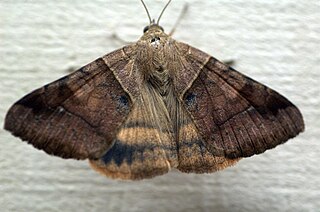
Mocis frugalis, the sugarcane looper, is a moth of the family Erebidae. The species was first described by Johan Christian Fabricius in 1775. It is found in several parts of the world, including India, Sri Lanka, West African countries and other Oriental regions. The adult is a fruit piercer and a major pest of crops.

Mocis undata, the brown-striped semilooper, is a moth of the family Erebidae. The species was first described by Johan Christian Fabricius in 1775. It is found in the Afrotropical and Oriental regions, including India and Sri Lanka.

Dordura is a monotypic moth genus of the family Noctuidae erected by Frederic Moore in 1882. Its only species, Dordura aliena, was first described by Francis Walker in 1865. It is found in the Indian subregion, Sri Lanka, Myanmar, Thailand, Peninsular Malaysia, Sumatra, Borneo and New Guinea.

Mythimna decisissima is a moth of the family Noctuidae first described by Francis Walker in 1856. It is found from India across south-east Asia including Hong Kong, Japan, Taiwan and Australia in Queensland and New South Wales. It is also present in South Africa.

Ctenoplusia limbirena, the Scar Bank gem, or silver U-tail, is a moth of the family Noctuidae. It is found in south-western Europe, Africa, the Canary Islands, Arabia, the southern Himalayas, India, Sri Lanka, Indochina to south-eastern China, Taiwan, Sulawesi, Bali and Timor. In New Zealand, it has been established since 2011.

Chadisra bipars is a moth of the family Notodontidae. It was described by Francis Walker in 1862 and is found in the Indomalayan realm.

Eucyclodes gavissima, the Oriental orange banded green geometer moth, is a species of moth of the family Geometridae described by Francis Walker in 1861. It is found in the Indian subregion, Sri Lanka, Bhutan, western China, Taiwan, Vietnam, Sumatra and Borneo.
Meganola brunellus is a moth of the family Nolidae. It is found in Sri Lanka, India, Taiwan, Japan, the Ryukyu Islands, Sundaland, Queensland and the Bismarck Islands. It is an introduced species in Hawaii.

Ambulyx substrigilis, the dark-based gliding hawkmoth, is a species of moth of the family Sphingidae. It was described by John O. Westwood in 1847.

Tiracola plagiata, the cacao armyworm, is a moth of the family Noctuidae. The species was first described by Francis Walker in 1857. It is found from south-east Asia, South India, Sri Lanka, Myanmar to the South Pacific Islands, including the northern two-thirds of Australia.

Ischyja manlia is a species of moth of the family Noctuidae first described by Pieter Cramer in 1776. It is found in the Indian subregion, Sri Lanka, Myanmar, Thailand, China, Okinawa, Sundaland, Sulawesi, Korea, the southern Moluccas, Australia (Queensland) and Palau. Adults pierce the skin of fruit to suck the juice.

Ramadasa pavo is a moth of the family Noctuidae first described by Francis Walker in 1856. It is found in south-east Asia. including Sumatra, Borneo, Sabah, Sulawesi, Thailand, Sri Lanka, India and China.

Teulisna tumida is a species of moth of the family Erebidae first described by Francis Walker in 1862. It is found in Borneo, Sumatra, China, India, Sri Lanka, Thailand and Taiwan.

Gesonia obeditalis is a species of moth of the family Noctuidae first described by Francis Walker in 1859. It is found from eastern Africa, the Seychelles, the Maldives and the Oriental tropics of India, Sri Lanka east to the Philippines, the Sula Islands and Australia. The adult moth has brown wings with a scalloped dark brown band near the margin. The hindwings are similar in pattern to the forewings but are a paler shade of brown.

Maliattha signifera is a species of moth of the family Noctuidae first described by Francis Walker in 1858. It is found in south-east Asia, including China, India, Japan, Taiwan, Korea and Thailand as well as in Australia (Queensland).
Sauris hirudinata is a moth of the family Geometridae. It was described by Achille Guenée in 1858. It is found in Fiji, Sri Lanka, India, Hong Kong, as well as on Peninsular Malaysia and Borneo.
Lemyra subfascia is a moth of the family Erebidae. It was described by Francis Walker in 1855. It is found in Sri Lanka.
Prionapteryx scitulellus is a moth in the family Crambidae described by Francis Walker in 1866. It is found in India, Sri Lanka and Kenya.

Bertula abjudicalis is a moth of the family Noctuidae first described by Francis Walker in 1859. It is found in India, Thailand, Laos, Vietnam, Taiwan and from Sri Lanka to Australia, where it has been recorded from New South Wales.

Chrysocraspeda abhadraca is a species of moth in the family Geometridae described by Francis Walker in 1861. It is found in Indian subregion including India and Sri Lanka, Peninsular Malaysia, Sumatra and Borneo.
















